Offshoring software development services is a powerful cost savings strategy compared to building or expanding an in-house development team.
Whether you’re a startup beginning from scratch or an established business that wants to hire an outsourcing partner to supplement your work, offshore software development companies are worth considering—which is why 99% of IT executives see value in outsourcing.
When considering outsourcing to places like India or Poland, certain questions and concerns naturally arise, such as:
- What are the best offshore software development rates by country?
- Do you have to sacrifice quality for cost savings?
- How does IT outsourcing impact communication and collaboration?
- How do you mitigate risks to improve your odds of delivering high-quality software?
This guide provides a thorough list of the average offshore software development rates by country, along with advice on how to prioritize quality, communication, and risk mitigation when reviewing software development outsourcing companies.
Average Software Development Hourly Rates by Region
IT outsourcing firms are located all around the world, and high-quality software engineers can be found on every continent humans call home.
That said, there are different offshore development hubs in specific cities around the world, and that’s where you’ll find most of the tech talent pool.
Due to cost of living differences across the world, certain countries offer high-quality software development services at a lower average hourly rate than others, and the IT industries in North America and Western Europe have greatly benefited from the cost savings.
What follows is a comprehensive list of software development rates in different countries, focusing on those considered major hubs for software engineering.
We’ve drawn these estimates from reputable sources like PayScale, SalaryExpert, and Indeed, so you can identify the average hourly rates in outsourcing destinations across the globe. We’ll also discuss the advantages and disadvantages of software development outsourcing to specific countries. Let’s dive into the hourly costs in major hubs throughout each region—those development destinations where the major tech talent is focused.
Asia
Asia is home to more than half the world’s population, and it’s a hotspot for many of the world’s leading offshore software development companies.
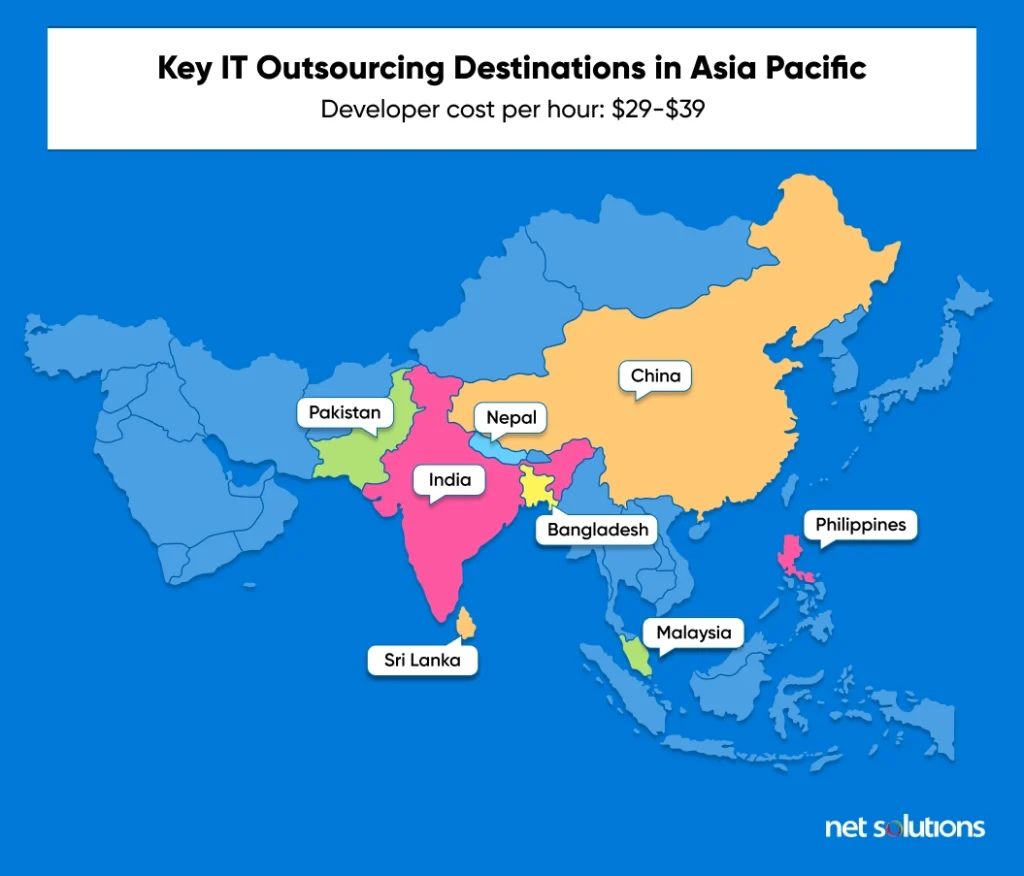
The time zone difference between Asia and Western tech centers makes it a popular outsourcing destination for North America and Europe—since these companies can issue work to development firms on the other side of the world while their in-house development team sleeps.
Of course, the time difference may hinder communication and collaboration as well, but that’s not a problem if you hire a software development firm that is willing to adapt to your working hours. That’s a service we offer here at Net Solutions, and many clients take us up on the offer.
One potential disadvantage of working with software development companies in Asia is that there might be a language barrier. For companies in English-speaking countries, or those who operate in English as a second language, this can be especially true of outsourcing to a country like China. By contrast, India and the Philippines stand out for the high level of English fluency among their educated populations.
India is the undisputed leader in outsourcing throughout Asia, with a vast talent pool of full-stack engineers, and it is a technology leader according to the Global Innovation Index.
A cost-effective choice, Indian software developers have the added benefit of understanding English-speaking cultures and the cultural norms of the Western world. Obviously, that’s not true of every Indian development company, but you’ll be able to tell quickly—often in that first conversation—if you’re dealing with a team that doesn’t understand your culture and hasn’t mastered your language at all.
On that note, wherever you choose to outsource your software development needs, be sure to have a conversation with your prospective project manager and perhaps even a few of the software engineers. That will give you a deeper sense of their comfort level with English (or whatever language your in-house staff speaks).
| Country | Hourly Rate |
|---|---|
| Bangladesh | $33 |
| China | $34 |
| India | $34 |
| Malaysia | $39 |
| Nepal | $33 |
| Pakistan | $29 |
| Philippines | $33 |
| Sri Lanka | $33 |
| Vietnam | $33 |
Eastern Europe
There are a number of software hubs throughout Eastern Europe and Central Europe, and unlike Western European countries, these countries offer highly competitive hourly rates due to their lower cost of living.
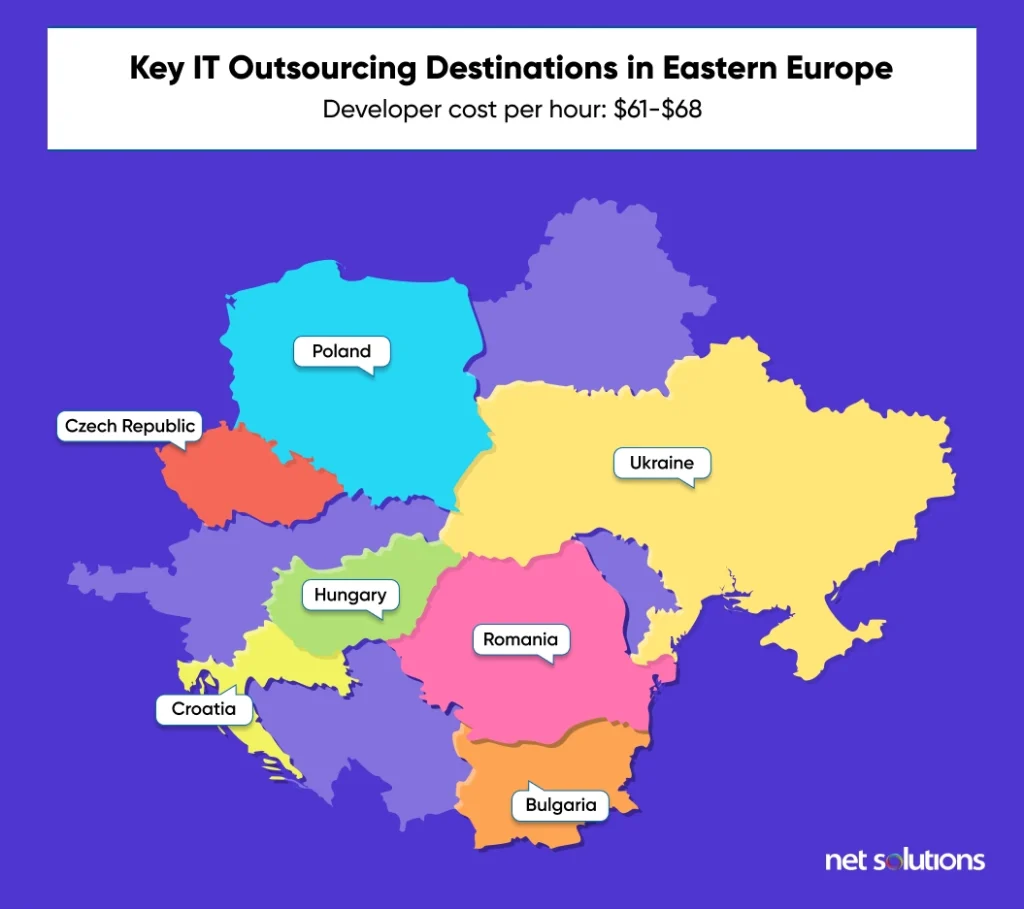
Eastern Europe is known for talented full-stack developers, along with specialists in C/C++, Java, Javascript, .NET, and Python. In particular, Ukraine, Hungary, and the Czech Republic have received high marks for their tech talent.
Yes, Ukraine remains on the list of strong software development outsourcing destinations despite the Russian invasion—a testament to the strength and determination of the Ukrainian people. While the war has taken a devastating toll on the lives and livelihoods of many in the country, thought leaders argue that it has not greatly reduced the scope of the Ukrainian software industry. Although software development in the region has struggled a bit due to the war, it still remains a force on the world stage.
Eastern Europe offers an advantage for European countries looking to hire developers who work in a similar time zone. This is one advantage to nearshoring for those companies who are interested in that option.
One of the challenges you might encounter working with certain Eastern European countries, however, is that complete English fluency is not nearly as widespread as it is in Germany, Sweden, and the Netherlands. In these countries, educated people often speak at a C1 level of fluency, which implies ease of communication that is near-native level. Some even possess a C2 level fluency, meaning they outperform many native English speakers.
Eastern Europe: $66 (Average Hourly Rate)
| Country | Hourly Rate |
|---|---|
| Bulgaria | $61 |
| Croatia | $66 |
| Czech Republic | $68 |
| Hungary | $65 |
| Poland | $67 |
| Romania | $64 |
| Ukraine | $67 |
Western Europe
Western Europe is a hot spot for tech talent, and you’ll find that many of the software development outsourcing companies there have a solid tech stack. As mentioned above, they’re also known for their command of English, especially in Germany, Sweden, and the Netherlands. The United Kingdom is also a hotspot for software development, and of course, English is not a problem there.
The downside of working with Western European firms is, of course, the price. Western Europe is economically vibrant, and the cost of living is much higher there than it is in much of the world. That means talented software engineers come at a premium price.
The Western European countries offer the strongest tech talent, and for those who aren’t concerned about budget—or for companies in these countries that want to nearshore or onshore their development—they don’t need to look much further than their own backyard.

Western Europe: $149 (Average Hourly Rate)
| Country | Hourly Rate |
|---|---|
| France | $107 |
| Germany | $121 |
| Netherlands | $137 |
| Sweden | $103 |
| United Kingdom | $184 |
Africa
The vast continent of Africa has a growing IT outsourcing market. Its focus is largely centered around software engineering at the moment, as opposed to design and other services.
However, its offerings are likely to grow in the coming years given that it has the largest population of young people in the world, and educational opportunities are expanding. By sharing similar time zones with Europe, African outsourcing companies can work side-by-side with many European countries.
North Africa—the area known as the Maghreb—features many hotspots for software development. Specifically, Egypt, Morocco, and Tunisia attract clients from Europe and around the world. North African programmers are known for specializing in Python, Ruby, SQL, and other important programming languages.
Morocco and Tunisia are popular software development outsourcing spots for companies in France due to the prevalence of French fluency there. South Africa is also a popular outsourcing destination, thanks to its high level of English fluency. South African developers are known for C++, PHP, and SQL skills.
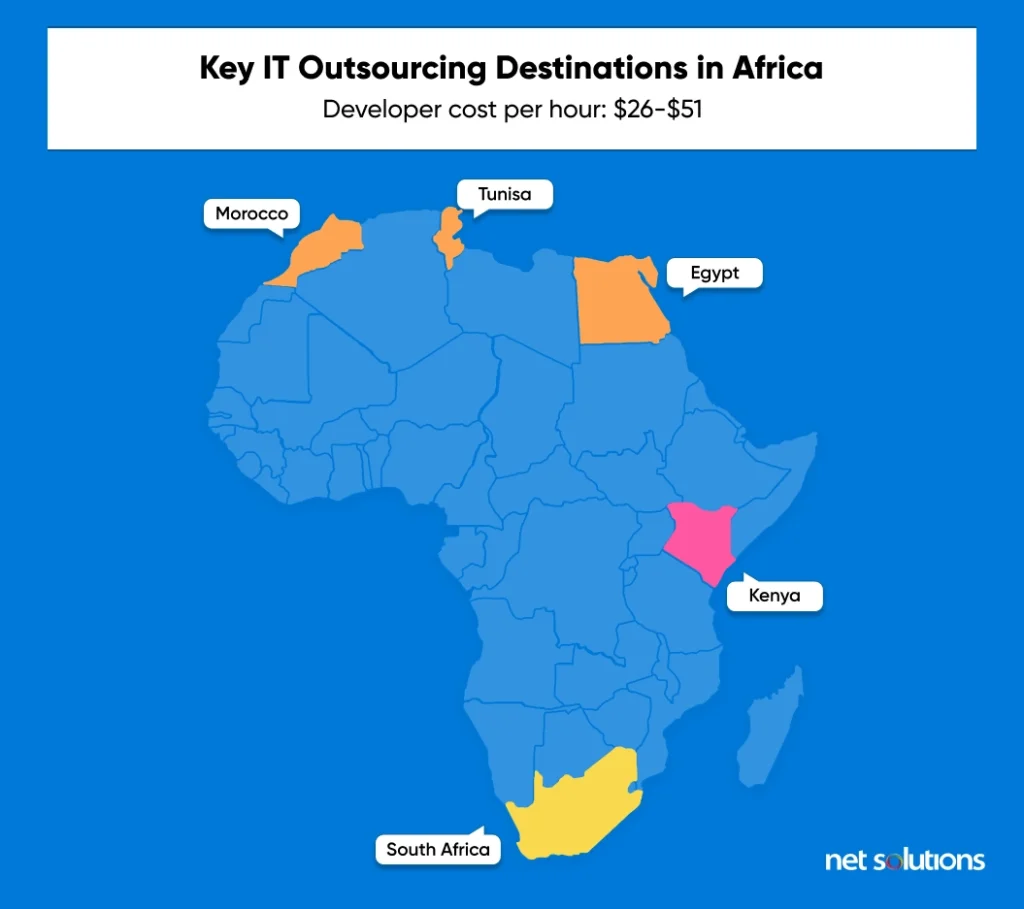
Africa: $39 (Average Hourly Rate)
| Country | Hourly Rate |
|---|---|
| Kenya | $28 |
| North Africa (Morocco, Tunisa, Egypt) | $26 |
| South Africa | $51 |
Latin America
According to Forbes Magazine, Latin America is quickly becoming a major source of cost-effective outsourcing, especially for the U.S. and Canada.
Those countries that need dedicated teams working in a similar time zone can benefit from hiring developers in places like Chile, Argentina, Mexico, Panama, and Brazil. Meanwhile, cities in the eastern part of Argentina and Brazil are in a strategic position to serve both North American companies on the East Coast and Western European companies.
Software development outsourcing rates in Latin America remain competitive for the most part, with particularly skilled developers found in Panama and Mexico. Mexico can have an advantage for U.S. companies as a nearshoring partner, given the high rate of English fluency in Mexico and its familiarity with U.S. culture.
Brazil is also an excellent place to find software development teams, although it has the disadvantage of being the only outsourcing destination in Latin America whose national language is not Spanish.
This would be an important factor for U.S. companies that plan to expand their operations to multiple Latin American countries, and if you need these development teams to easily communicate with each other.
Panama is another popular choice, and the World Bank Group named this Central American country one of the fastest-growing major economies in the world. Panama is gaining a strong presence in the IT market, and developer salaries remain competitive.
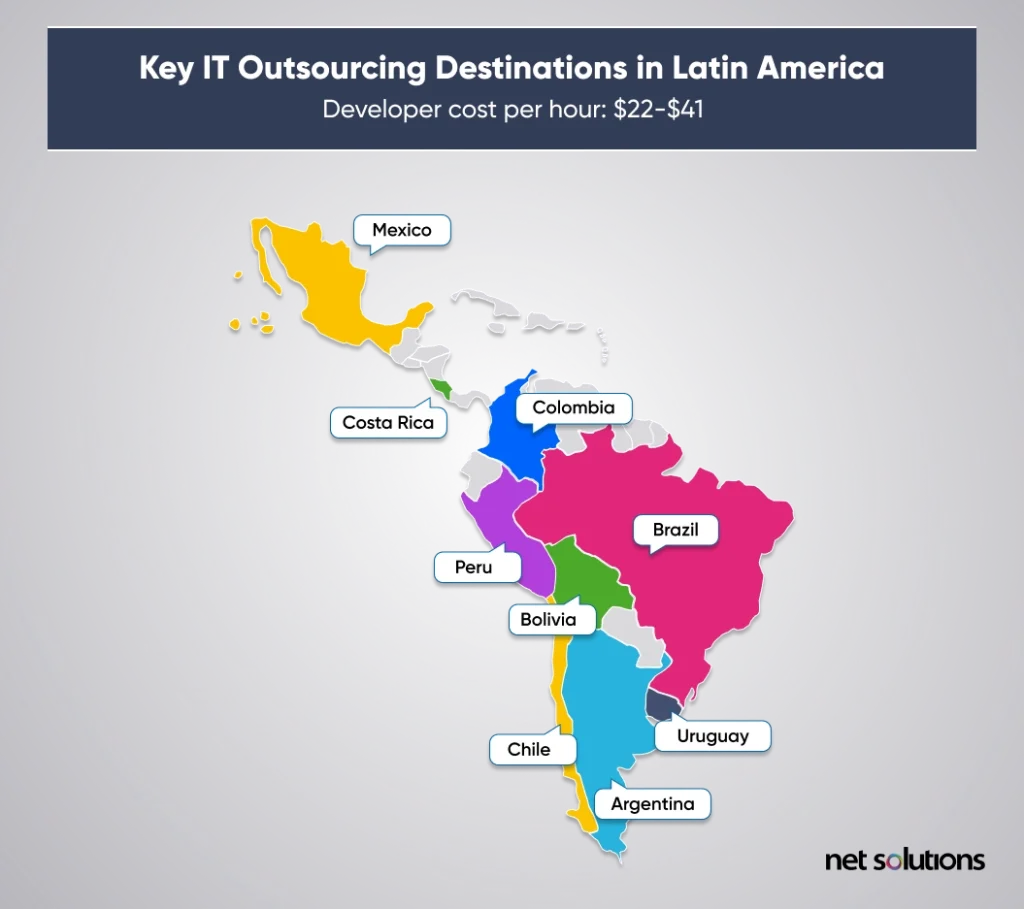
Latin America: $41 (Average Hourly Rate)
| Country | Hourly Rate |
|---|---|
| Argentina | $34 |
| Bolivia | $22 |
| Brazil | $30 |
| Colombia | $34 |
| Costa Rica | $30 |
| Chile | $37 |
| Mexico | $41 |
| Peru | $26 |
| Uruguay | $41 |
North America
North America has always been on the cutting edge of software development, and while Silicon Valley (just outside San Francisco, CA) always comes to mind, other tech hubs have popped up across the U.S. and in neighboring Canada.
Outsourcing to the United States or Canada has obvious advantages, especially for other North American companies looking for top-notch IT services and zero communication challenges or cultural differences.
That said, North American software developers come at a hefty price, and you can find much less expensive development teams around the world who are perfectly fluent in English. Just make sure your offshore development partner has a track record of successfully serving companies from the USA and you’ll be fine.
One thing you’ll notice about rates across North America is that they vary considerably—more so than you might imagine for a single country. In fact, the cost of living in the United States varies significantly from one state to the next, and even from one city to another (within the same state).
Unfortunately, most of the technology hubs in the U.S. are located in expensive cities. In fact, part of the reason rent is so expensive in San Francisco is that it’s packed with employees from major tech firms and well-funded startups. Their employees make hundreds of thousands of dollars each year, and they drive up rent prices.
Canada can be a bit more cost-effective than the USA, but once again, senior developers in Canada are concentrated in major tech centers like Vancouver, British Columbia. The Vancouver cost of living is similar to other West Coast cities like Los Angeles and Seattle, making it an expensive software development outsourcing destination.

North America: $182 (Average Hourly Rate)
| Country | Hourly Rate |
|---|---|
| California | $200 |
| New York | $149 |
| Texas | $135 |
| Washington | $220 |
| Canada | $134 |
Australia & New Zealand
The tech industries in Australia and New Zealand are growing at a steady rate of 3.1% every year, according to IBIS World research. As outsourcing destinations, however, they struggle to keep up with other regions.
Why do they find it so difficult to keep up with Asia and Latin America? One reason is that they’re much more expensive due to their higher cost of living. Plus, places like India offer many of the same advantages for North American developers at a much lower price tag.
For example, if a U.S. company wants to work around the clock, having software development outsourcing partners handle tasks on the opposite side of the world while their engineers aren’t working, they can hire Indian developers to do that at much better rates.
Meanwhile, if a company in Japan wants to work with developers in a nearby time zone, they can work with teams in Vietnam. Both options are far more cost-effective than hiring someone in Australia or New Zealand.
The advantages Australia and New Zealand offer are that they have a strong pool of tech talent, and English is their national language.
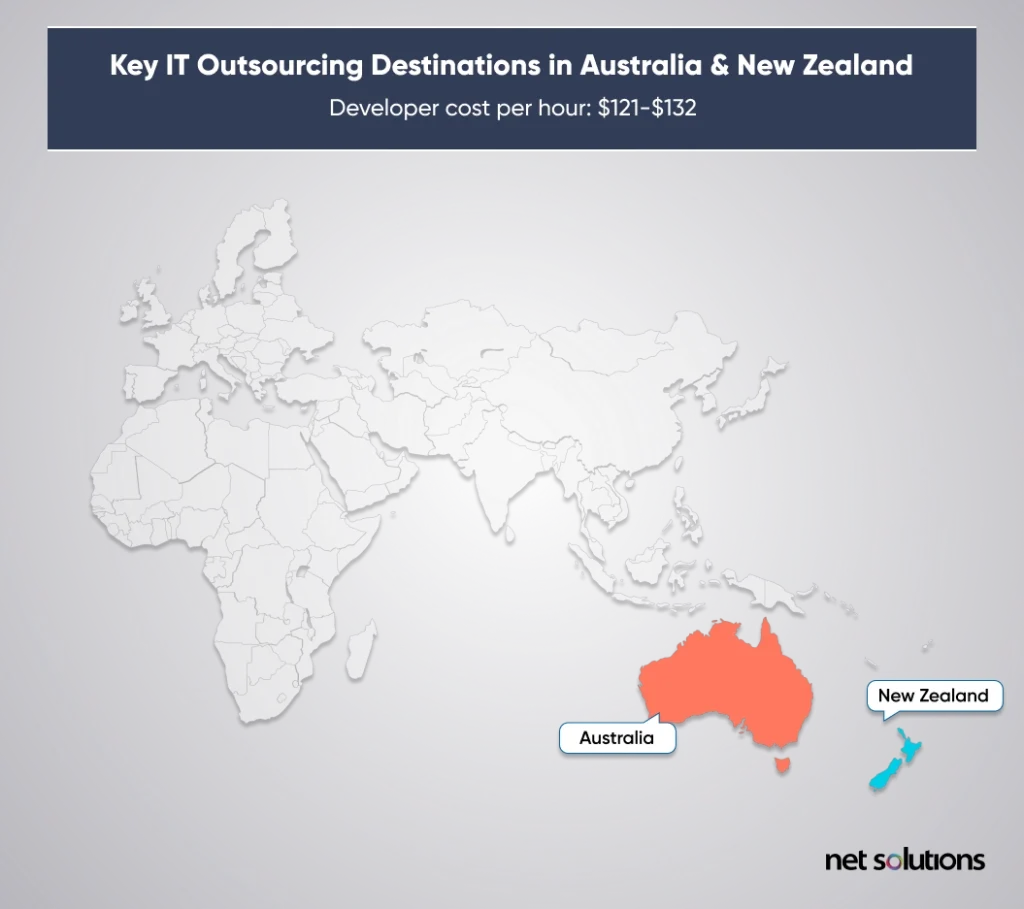
Australia & New Zealand: $127 (Average Hourly Rate)
| Country | Hourly Rate |
|---|---|
| Australia | $132 |
| New Zealand | $121 |
Benefits of Hiring Offshore Developers
Working with offshore development teams offers a number of benefits to established companies and startups alike. In fact, a recent report found that offshoring is expected to grow by 70% this year, with many businesses outsourcing at least some part of their software development efforts.
Here are some of the benefits associated with hiring offshore developers.
- Cost savings: Offshoring is an effective cost-saving tool. Above and beyond labor costs, there are hidden costs associated with hiring in-house employees, from payroll and benefits to downtime when they’re not producing.
- Access to a larger talent pool: There are excellent developers all around the world, and when you outsource your development, you have access to a wider selection of top-notch talent.
- Scalability: Growth is both exciting and challenging. Companies staffed entirely with in-house employees may struggle to keep up with demand, and outsourcing some or all of their tech needs can help them grow smoothly.
- Increased flexibility: If growing companies hire too quickly, they may end up paying for labor they’re not ready to use, leaving them with downtime and massive overhead that could drive them into the ground. Offshoring empowers them to be flexible.
- Around-the-clock production: Working with outsourcing companies in different time zones can enable continuous development, with outsourced teams working while in-house teams sleep.
How to Hire the Best Offshore Development Team
If you’re considering hiring an offshore development team, there are a number of important factors to consider beyond costs. From quality to communication skills to payment strategies, it’s important to understand exactly what your potential software development outsourcing partners have to offer before you sign any contracts.
You might start with a Request for Proposal (RFP), or you can reach out directly to potential outsourcing partners who specialize in projects like yours.
What is their quality of work?
The most important factor when choosing an outsourcing partner is the quality of work they produce. After all, dirt-cheap software—even for a Minimum Viable Product (MVP)—can torpedo your chances of success in the long run.
The good news is that you don’t have to sacrifice quality for competitive rates. There are plenty of talented offshoring development teams who can work within a reasonable budget and still produce amazing results. Finding them is a matter of strategically vetting your candidates and selecting the best. Here are five factors you can use to evaluate each potential software development outsourcing partner.
1. Portfolio
Review your prospective partner’s portfolio and make sure they have experience in the following areas:
- Building similar applications that work on the platform(s) you want to serve
- Providing strategic guidance rather than simply acting as order takers
- Working in the programming languages you require
- Designing software, project management, QA, or any other skills that go beyond programming
- Working with both startups and established businesses
2. Client Case Studies and Testimonials
Any reputable and experienced firm should have a long list of satisfied clients, and those that are serious about their business will have a long list of case studies (also known as client success stories) and testimonials that back up their claims.
You can also look up public reviews on websites like Clutch to see if those public assessments line up with the outsourcing company’s case studies.
3. Your Own Evaluation
Once you’ve narrowed your options down to your top set of vendors, it’s time to evaluate them through formal interviews. This should include:
- Conversations with prospective project managers
- Technical interviews where you determine how their engineers would approach a given problem
- Code reviews
- Formal assessments
- Thoughtful discussions among your team where you weigh your options and select the best
Are There Any Communication Challenges?
Communication challenges are inherent in any business relationship, even when an entire team is located in the same office and speaks the same native language. Add language and cultural differences to the mix, and those challenges may increase—unless you choose the right software development outsourcing partner upfront.
We recommend having an in-depth discussion with potential outsourcing partners surrounding their:
- Level of English fluency (or fluency in whatever language your team speaks) among their engineers as well as project managers
- Time zone differences and whether their staff is willing to adapt to your working hours (if that’s something you require)
- Experience working with people from your culture
- How they approach things like roadmapping, ticket tracking, and development-related communication concepts
Another important factor is the strategy they take toward communication and collaboration, including whatever software development methodologies they use. For example, do they specialize in an Agile Scrum approach? Do they work with some other methodology that matches your approach?
Communication is a skill, just like software design and development. As a soft skill, it can be a bit harder to assess than coding talents, but you can get a clear sense of a prospective vendor’s communication skills by how comfortable they are explaining their strategy.
Software development methodologies were created to address the fundamental challenges involved in building complex software. If a potential vendor embraces some of those methodologies, which every engineering team should these days, then have a conversation with them about their philosophy.
You know they’ve given a good deal of thought to overcoming communication challenges if they can clearly explain the role Agile (or another methodology) fits into their software development process.
What payment methods are available?
Offshore development companies use a variety of different payment plans, and you will want to ask about your options up front to make sure they can accommodate your ideal approach. Different plans have different advantages and disadvantages, which we’ll explore here.
1. Fixed-price Contracts
A fixed-price contract is a project where you agree to a set price for all the deliverables, usually paying a significant deposit upfront. With fixed-price projects, you will spend a fair bit of time in meetings in the beginning, setting the scope of the project. That’s because it’s very important to identify what the deliverables will be and what you’re paying to receive them.
The advantage to this approach is that you know what you’re paying upfront so there’s no risk of going over budget. On the downside, there’s very little leeway to modify things if you need some revisions. At that point, you must be willing to enter into a new contract that expands the deliverables.
2. Time and Material Contracts
A contracted payment approach based on time and materials means that you pay the outsourcing agency based on hourly labor for specific services. The design rate would typically differ from the development rate or the project management rate, and senior developers cost more than junior developers. You would also pay for any additional costs to produce the final product (that’s the materials part of the equation).
The advantages of a time and materials contract are that it affords you great flexibility, and it works well for ongoing projects. The disadvantage is that the final budget is more difficult to predict.
3. Milestone-based Payments
Milestone-based payments involve paying for specific deliverables piecemeal, at various stages, once the software development outsourcing partner delivers them. Just like a fixed-price contract, you will need to spend a fair bit of time establishing the scope of the project and each milestone.
That way you’ll know exactly what you’re getting (and what you’re paying for) along the way.
Ready to Hire an Offshore Team?
If you’re considering offshoring your software development to India, talk to our team here at Net Solutions. We have more than three decades of experience working with leading brands around the world—from the United States to Europe to Australia.
We’ve worked with world leaders like American Golf and Euro Cart Parts, and we’ve created MVPs for many, many startups.
Whether you’ve got a thoroughly fleshed-out project or the seed of an idea, we can help you review your options and assemble a plan. It all starts with a conversation, so let’s talk!





